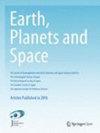Seismic signature detection during the 2018 Anak Krakatau flank collapse and tsunami using seismic amplitudes from regional-scale monitoring
IF 2.5
3区 地球科学
引用次数: 0
Abstract
Abstract On 22 December 2018, the major flank collapse of Anak Krakatau volcano generated a tsunami that struck the surrounding coasts of Java and Sumatra islands in Indonesia without warning. It was later suggested that the corresponding seismic event lacked the body-wave arrivals typical of tectonic earthquakes, causing difficulties for the automated detection system to recognize the event. We explore the possibility of detecting the seismic signature of such events without relying on the arrival times of body waves, by measuring seismic amplitudes in a regional seismic network at the expected arrival times from a fixed, potential source and comparing them to the theoretical attenuation of surface waves. We propose a fast detection method and evaluate the method using seismograms recorded during the flank collapse and tsunami episode as well as several known tectonic earthquakes. Detailed examinations of the detection results confirm the seismic signatures of the flank collapse and teleseismic events as suggested by previous studies. We also find more seismic signatures suggesting the occurrence of two possible smaller collapse events and variations in the eruptive activity related to the major flank collapse, as well as body and surface wave signals from two teleseismic earthquakes that were present during this episode. Finally, we construct a timeline of events during this devastating episode, combining our results with previous studies as well as insights from weather radar observations. With the ability to detect and discriminate various types of seismic events from each other, the detection method can be useful in assisting the existing monitoring and early warning systems in detecting major volcano-related tsunamigenic events. Graphical Abstract利用区域尺度监测的地震振幅检测2018年喀拉喀托火山侧翼崩塌和海啸期间的地震特征
2018年12月22日,喀拉喀托火山主要侧翼崩塌引发海啸,在没有预警的情况下袭击了印度尼西亚爪哇岛和苏门答腊岛周边海岸。后来有人提出,相应的地震事件缺乏典型的构造地震体波到达,导致自动探测系统难以识别该事件。我们探索了在不依赖于体波到达时间的情况下检测此类事件地震特征的可能性,方法是在固定潜在震源的预期到达时间测量区域地震台网中的地震振幅,并将其与表面波的理论衰减进行比较。我们提出了一种快速检测方法,并利用在侧面崩塌和海啸事件期间记录的地震记录以及几次已知的构造地震来评估该方法。对探测结果的详细检查证实了以前研究中提出的侧翼塌陷和远震事件的地震特征。我们还发现了更多的地震特征,表明发生了两次可能较小的崩塌事件和与主要侧翼崩塌有关的喷发活动的变化,以及在此事件中出现的两次远震地震的体波和面波信号。最后,我们将我们的研究结果与之前的研究结果以及气象雷达观测结果相结合,构建了这一灾难性事件的时间轴。该检测方法具有检测和区分不同类型地震事件的能力,可以帮助现有的监测和预警系统检测与火山有关的主要海啸事件。图形抽象
本文章由计算机程序翻译,如有差异,请以英文原文为准。
求助全文
约1分钟内获得全文
求助全文
来源期刊

Earth, Planets and Space
地学天文-地球科学综合
CiteScore
5.80
自引率
16.70%
发文量
167
期刊介绍:
Earth, Planets and Space (EPS) covers scientific articles in Earth and Planetary Sciences, particularly geomagnetism, aeronomy, space science, seismology, volcanology, geodesy, and planetary science. EPS also welcomes articles in new and interdisciplinary subjects, including instrumentations. Only new and original contents will be accepted for publication.
 求助内容:
求助内容: 应助结果提醒方式:
应助结果提醒方式:


